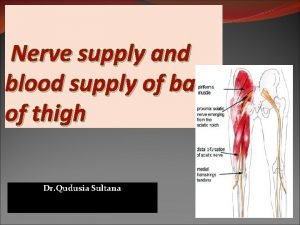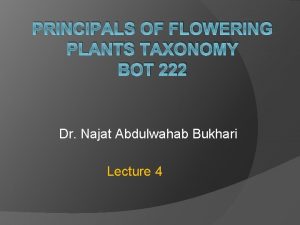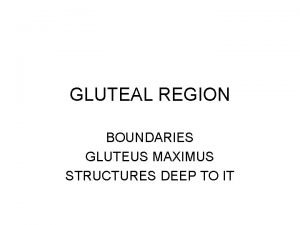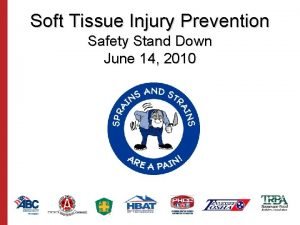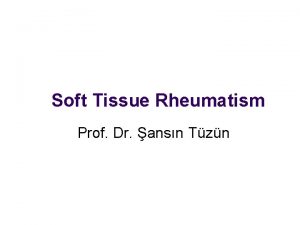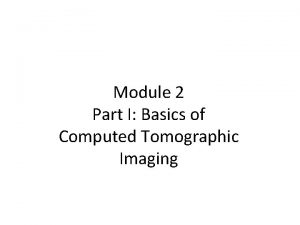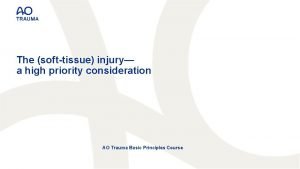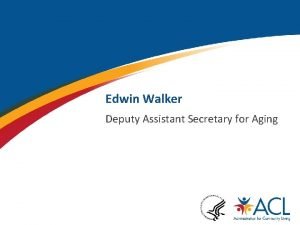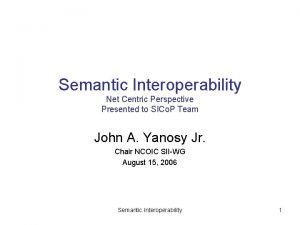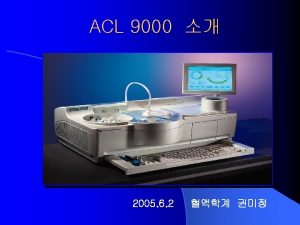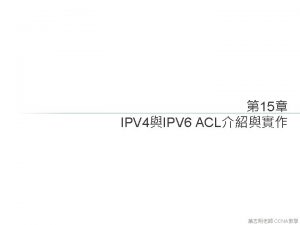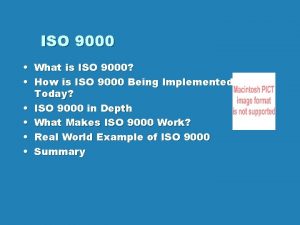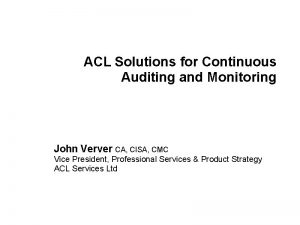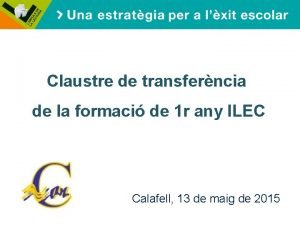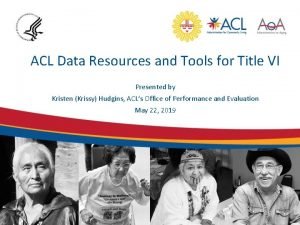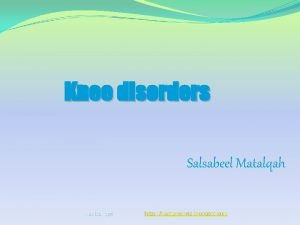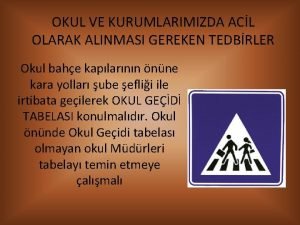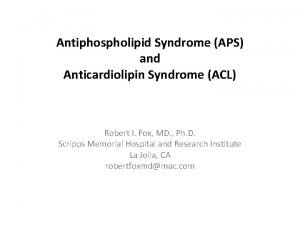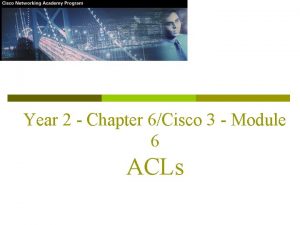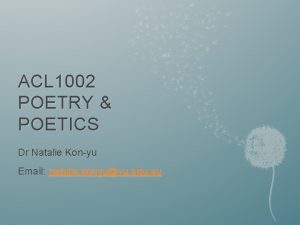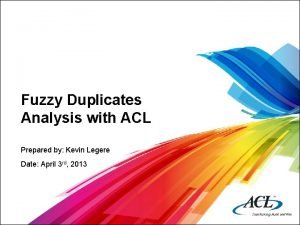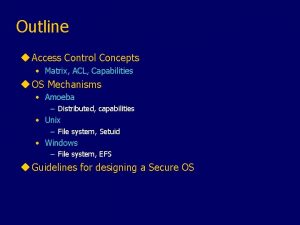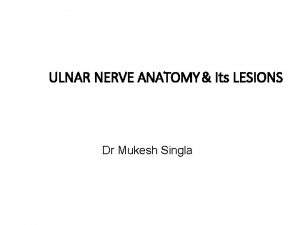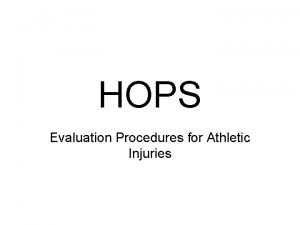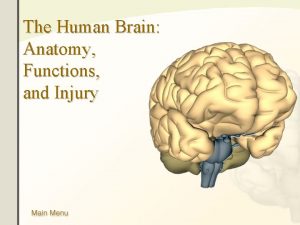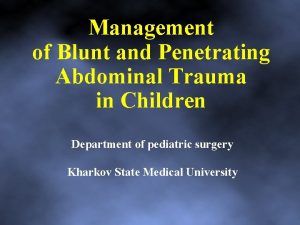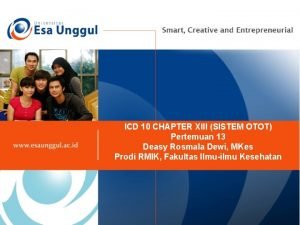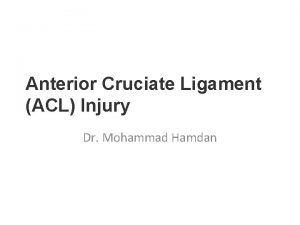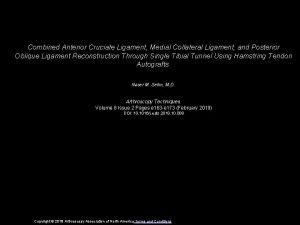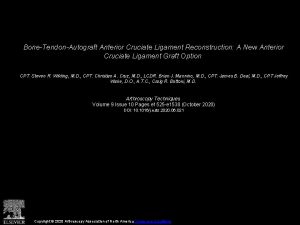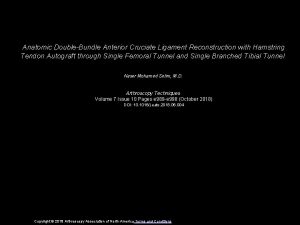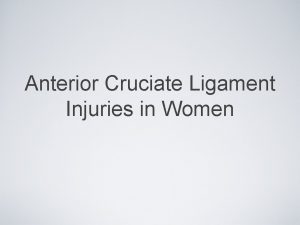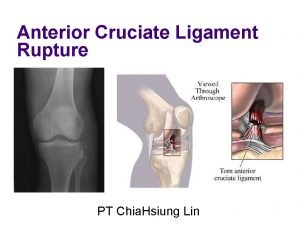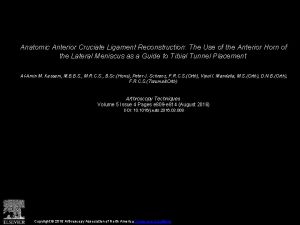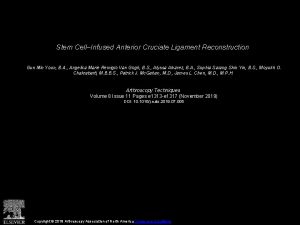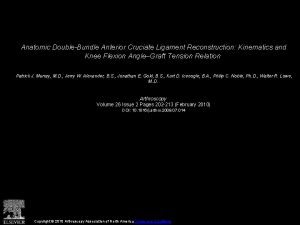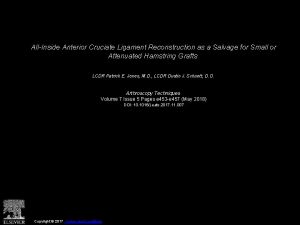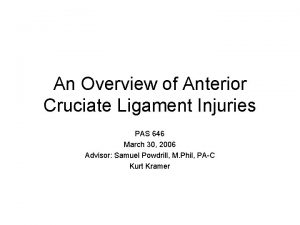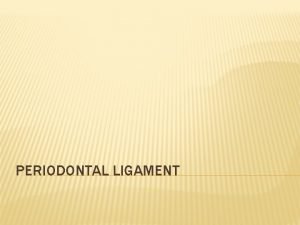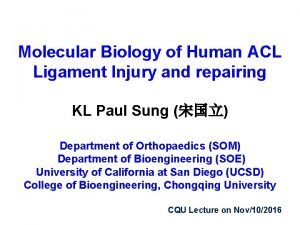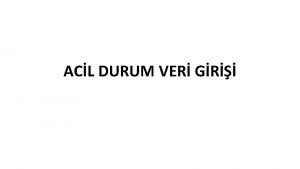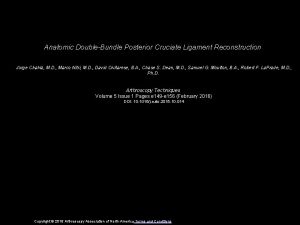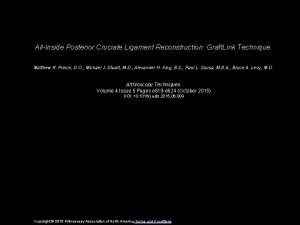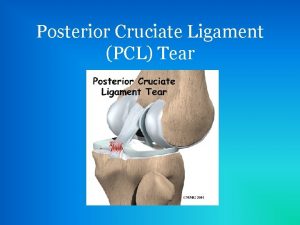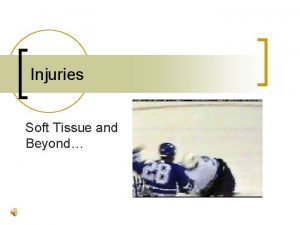Soft tissue injury Anterior Cruciate Ligament ACL Dr












































- Slides: 44

Soft tissue injury: Anterior Cruciate Ligament (ACL) Dr. Niketa Patel

Objectives After completing this lecture, you will be able to: 1. Retrieve anatomy and biomechanics of ACL 2. Explain mechanism of injury and clinical features 3. Explain principles of assessment for ACL injured knee joint 4. Demonstrate special tests for ACL injury 5. Implement functional test for ACL injury 6. Apply Evidence based Learning

Introduction • Ligament injuries occur most frequently in individuals between 20 to 40 yrs of age as a result of sport injuries but can occur in individuals of all ages. • The ACL is most commonly injured ligament. • Often more than 1 ligament is damaged as the result of a single injury.

Anatomy • The cruciate ligaments cross each other and are the primary rotary stabilizers of the knee. • These strong ligaments are named according to their attachment to the tibia and are intracapsular but extrasynovial. • Each ligament has an anteromedial and a posterolateral portion. • The ACL has in addition an intermediate portion.

Anatomy (contd…) • ACL extends superiorly, posteriorly and laterally, twisting on itself as it extends from tibia to the femur. • Its main function are to prevent anterior translation of tibia on femur. Also to check lateral rotation of tibia in flexion. • To lesser extent it helps to check extension and hyperextension at the knee.

Anatomy (contd…) • It also helps to control the normal gliding and rolling movement of the knee.

Biomechanics • At 00 of knee flexion the AMB is at its shortest length (lax) while the PLB is at it longest length (taut). • So at 00 the lax AMB would be able to offer least restraint and the taut PLB would be able to offer the most restraint. • At 300 of knee flexion the AMB has lengthened so that it is longer than PLB.

Biomechanics (contd…) • Under valgus loading the length of both bands of the ACL increases as knee flexion increases. • Anterior loading alone or combined with valgus loading causes an increase in length of all portions of the ACL with increase in knee flexion. • In flexion, AMB is taut, (maximally tensed at 700 of flexion) and PLB is lax.

Biomechanics (contd…) • Forces producing anterior translation of the tibia will result in maximal excursion of the tibia at about 300 of flexion when neither of the ACL bands are particularly tensed. • Passive extension of the knee generated forces in the ACL only during the last 100 of extension.

Biomechanics (contd…) • The PLB checks and tends to be injured with excessive hyperextension of knee whereas AMB tends to get injured in flexed knee trauma. • As ACL contributes less in preventing valgus and varus stresses. But if MCL is damaged then ACL plays major role in restraining the varus and valgus stresses.

Biomechanics (contd…) • Torn ACL leads to a loss of normal proprioception at the knee.

Mechanism of Injury • Usually a history of non-contact injury. • But ACL injury can occur from both contact and non-contact mechanism. • The most common contact mechanism is a blow to the lateral side of the knee resulting in the valgus force to the knee.

Mechanism of Injury (contd…) • Frequently valgus force is accompained by injury to the posteromedial capsule, medial meniscus and ACL. (terrible triad) • The most common mode of injury in non contact mechanism is external rotation with abduction of the flexed knee or hyperextension of knee in internal rotation, deceleration.


Mechanism of Injury (contd…) • Hyperextension leads to ACL injuries often associated with meniscus tears.

Clinical features • This is a disabling injury and the knee may immediately collapse and is painful. • Following trauma, the joint usually does not swell for several hours. If blood vessels are torn, swelling is usually immediate. • If there is a complete tear, instability is detected when the torn ligament is tested.

Clinical features (contd…) • When swollen, motion is restricted, the joint assumes a position of minimum stress (usually flexed 25), and inhibition (shut down) of the quadriceps muscle occurs. • When acute, the knee cannot bear weight, and the person cannot ambulate without an assistive device.

Clinical features (contd…) • With a complete tear, there is instability, and the knee may give way during weight bearing.

Principles of Physiotherapy Assessment

History • A detailed history and description of the MOI are vitals components to initial evaluation. • MOI questions can guide to what structures can be injured. • Popping sensation felt or heard at the time of injury indicates ACL tear.

History (contd…) • Deceleration injuries also affects cruciate ligaments. • Constant speed with cutting may involve ACL. • Does the knee “gives way”? This finding usually indicates instability in the knee.

On examination • Swelling : Does the joint is swollen? • Has swelling occurred immediately after injury or after several hours of injury? • Fluid accumulation within 2 hrs of injury indicates the possibility of a hemarthrosis, which could result from an ACL tear. • Swelling with activities can occur due to instability.

On examination (contd…) • Pain parameters: the existence of pain, onset of pain and whether the patient can walk without pain are good indicators of the extent of injury. • Generalized pain in the area of the knee is usually characteristics of partial tears of muscles or ligaments.

On examination (contd…) • Instability: Instability rather than pain is major presenting factor in complex ligament disruptions.

Active ROM • The examination is performed initially with patient in sitting position and then with patient in lying position. • While patient performing active ROM, examiner must observe following: ü The ROM is available

Active ROM (contd…) • Normal knee ROM: ü Knee flexion 00 to 1350 ü Knee extension 00

Passive ROM • If active ROM is full then gentle overpressure should be applied to check the end feel of various movements of the tibiofemoral joint. • Normal End-feels: ü Knee flexion is tissue approximation ü Knee extension is tissue stretch

Passive ROM (contd…) ü Whether pain occurs during the movement. And if so where? ü What appears to be the limiting the movement? • The active movement can be done in sitting or supine position and the most painful movement must be checked at last.

Resisted Isometrics • For a proper test of the muscles, resisted isometric movements must be performed. • The patient should be in supine position. • Ideally this resisted isometric movements are performed in its resting position.

Special tests for ACL injury • It may be necessary to carry out specific tests of the injury to differentiate it from other injury with similar clinical features.

Tests for ACL • Anterior Drawer Test: • Patient position is supine • Then flex the patient hip to 450 and knee flexion to 800 or 900 with the foot flat on the table.

Tests for ACL (contd…) • The examiner sits on the table positioning his/her buttocks on the patient’s dorsum of the foot to fix it firmly. • The examiner’s hand are placed about the upper part of the tibia. • The examiner provides a gentle pull repeated in an anterior direction.

Tests for ACL (contd…) • Lachman test: It is the best indicator to ACL injury, especially with posterolateral band. • It is the test for 0 ne-plane instability. • The patient lies supine. • Examiner passively flexes the patient’s knee 300 of flexion. • This position is functional position of the knee in which ACL plays an major role.

Tests for ACL (contd…) • The patient’s femur is stabilized with one of the examiner while the proximal aspect of the tibia is moved forward with the other hand. • A positive sign is indicated by a soft end feel when the tibia is moved forward on the femur.

Functional assessment • Instability produced on examination table are easily produced functionally. • Especially in athletes who participates in activities such as vigorous cutting, jumping or rapid deceleration which produces high physiological joint loads.

Functional assessment (contd…) • If active, passive and resisted isometrics are performed with little difficulty, the examiner can test the patient functionally by applying functional tests to see whether this sequential activities produces pain or other symptoms. • This test may be scored by the time taken to do the test or by the distance or height attained when doing the test.

Functional assessment (contd…) • Single-leg hop test: With this test, the patient is assessed for the time taken to hop 6 meters on one leg. • The good leg is test first followed by the injured leg.

Evidence Based Learning A PROSPECTIVE ANALYSIS OF INCIDENCE AND SEVERITY OF QUADRICEPS INHIBITION IN A CONSECUTIVE SAMPLE OF 100 PATIENTS WITH COMPLETE ACUTE ACL RUPTURE

JOURNAL & NAME OF AUTHORS STUDY DESIGN & LEVEL OF INCIDENCE Journal of Prospective orthopedic study design Research Level of evidence – 2 Terese L. , Scott Stackhous e, Michael J. , Lynn Snyder. AIMS METHODOLOGY CONCLUSION The purpose of the study was to systematically examine the incidence and severity of Q’ceps voluntary activation failure in both L. E. after ACL injury. 100 consecutive patients with acute ACL rupture were tested when ROM was restored and effusion resolved, an average of 6 wks after injury. A burst superimposition technique was used to assess Q’ceps muscle activation and strength in all patients. The inhibition of voluntary Q’ceps activation on involved side was 3 times that of uninjured acute young subjects but magnitude was not large. The incidence of Q’ceps inhibition on the uninjured side was similar to the injured side.

MCQs 1. ACL main function is to prevent ____ translation of tibia on femur. a. posterior b. anterior

MCQs (contd…) 2. In Lachman’s test, patient knee is flexed to how many degrees? a. 300 b. 450 c. 500 d. None of the above

MCQs (contd…) 3. ____ is major presenting factor in complex ligament disruptions. a. Pain b. Instability c. swelling

MCQs (contd…) 4. In anterior drawer test, the examiner ______ a. Push the tibia posteriorly b. Pulls the tibia anteriorly

MCQs (contd…) 5. Hyperextension leads to ______ injuries often associated with meniscus tears a. PCL b. LCL c. ACL d. Both a and b
 Popliteal pulse location
Popliteal pulse location Root value of tibial nerve
Root value of tibial nerve Cruciate corolla
Cruciate corolla Trochanteric anastomosis
Trochanteric anastomosis Intentional injury
Intentional injury Soft tissue rheumatoid arthritis
Soft tissue rheumatoid arthritis Hémorragie en flammèche
Hémorragie en flammèche Soft tissue examples
Soft tissue examples Chapter 14 bleeding shock and soft tissue injuries
Chapter 14 bleeding shock and soft tissue injuries Soft tissue rheumatism
Soft tissue rheumatism Soft tissue hounsfield units
Soft tissue hounsfield units Gustilo classification
Gustilo classification Perforation plates
Perforation plates Acl rules
Acl rules Edwin walker acl
Edwin walker acl Netcentric acl tool
Netcentric acl tool Aruba mesh portal
Aruba mesh portal Acl 9000
Acl 9000 Acl training
Acl training Okul afete hazırlık planı
Okul afete hazırlık planı Acl established
Acl established Used il acl 9000
Used il acl 9000 Cisco acl mac address
Cisco acl mac address Acl solutions
Acl solutions Acl in ccna
Acl in ccna Energia solar viquipedia
Energia solar viquipedia Acl oaaps
Acl oaaps Drawer test
Drawer test Acl okul
Acl okul Acl antibody
Acl antibody Acl ppp
Acl ppp Keats acl
Keats acl Bert lda
Bert lda Fuzzy duplicates acl
Fuzzy duplicates acl Eldercare.acl.gov
Eldercare.acl.gov Acl audit exchange
Acl audit exchange Fipa acl
Fipa acl Acl vs capability list
Acl vs capability list Nerve compression syndrome
Nerve compression syndrome Hops meaning sports med
Hops meaning sports med What part of the brain is responsible for what
What part of the brain is responsible for what Injury evaluation questions
Injury evaluation questions Lund and browder chart formula
Lund and browder chart formula Weinert and kulenkampff sign
Weinert and kulenkampff sign Kode icd 10 dislocation genu
Kode icd 10 dislocation genu

